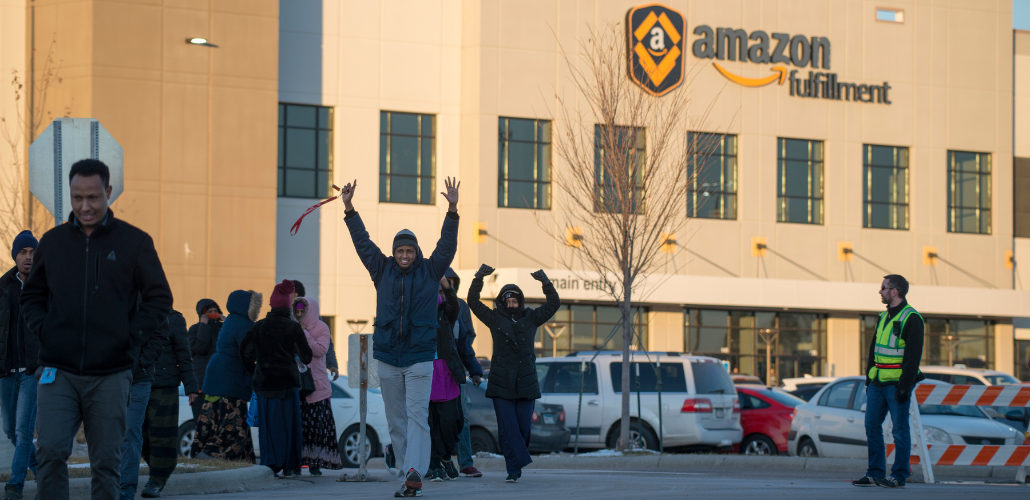Viewpoint: There’s More to Amazon Organizing Strategy Than Choke Points

Workers walked out of an Amazon fulfillment center in Minnesota in 2018, protesting the dangerous pace of work. Each type of facility has its own organizing challenges: fulfillment centers have a more cohesive workforce, but less leverage to disrupt Amazon's logistics chain than sortation centers. Photo: Fibonacci Blue (CC BY 2.0)
As a longtime Amazon warehouse worker and union activist, I was glad to see Professor Ben Fong’s strategic analysis calling on the union movement to focus Amazon organizing on the Sortation Centers.
But while I agree that the SCs are clear choke points in Amazon’s system, this sort of choke point analysis is only one component of an effective organizing strategy. When you look at the bigger picture, I think the argument for focusing on the SCs runs into trouble.
A QUICK OVERVIEW
Sortation Centers are intermediate cross-docking facilities that aggregate packages from many Fulfillment Centers and perform a rough sort to supply a grouping of local Delivery Stations or post offices.
For a fuller overview of Amazon’s logistics network you can see the article (with maps!) from the blog run by Fong and Teamsters for a Democratic Union organizer Scott Jenkins. But for the sake of this argument I can give a simplified overview.
Inventory enters Amazon’s system from suppliers at Inbound Cross-Dock facilities, often associated with ports, where shipping containers and pallets are broken up and shipped to Fulfillment Centers, where the active inventory is stored and orders are picked and packaged.
Fulfillment Centers aggregate packages by rough geographic area and send them to Sort Centers, where they are sorted into trucks bound for Delivery Stations, the small local facilities where the Amazon delivery vans are loaded. Parallel to this is a network of air freight facilities that send inventory across the country when it’s not available locally.
FRACTURED WORKFORCE
Having worked and organized in a few Amazon warehouses, and spoken with workers organizing in many more, I have a few arguments for why SCs are not the most promising target.
To start with, when we organize workers we’re not doing it from scratch—organization already exists in how management has set up the shifts, departments, and jobs. Amazon sets the shift pattern in SCs to make them particularly high-turnover, nearly entirely part-time (so workers have low investment in the job), and maximally fractured.
Shifts at SCs are almost all four hours long, with management reserving the option to “flex up” or “flex down” the shift by up to an hour on as little as 20 minutes’ notice. These short shifts are separated by an hour or two of down time, so workers seeking a full-time schedule have an unpaid (and unpredictable) break between shifts. In total there are four to five non-overlapping shifts every day; many groups of workers with little to no interaction with each other.
Notably, union committees have made significant progress at Delivery Stations, Delivery Service Providers, air hubs, and Fulfillment Centers. No one has made significant progress at an SC that I’m aware of.
NOT HARD TO CLOSE
Then, especially since the Amazon union movement has to grow shop by shop—the company is too big to organize an underground campaign across all facilities at once—we need to worry about the company closing a facility and relocating the work.

SUPPORT LABOR NOTES
BECOME A MONTHLY DONOR
Give $10 a month or more and get our "Fight the Boss, Build the Union" T-shirt.
While Fong is correct that each SC serves a local geographic area and thus can’t move very far, I think he underestimates the risk. SCs have a relatively low capital investment, usually just a few (often leased) conveyor belts, making them easy to open, move, or rearrange. I have not heard of any significant automation investments in SCs, except those attached to air freight facilities.
As I have experienced, having Amazon close a unionizing facility, even if all workers get transferred to other nearby facilities, is a traumatic experience for many workers and a major blow to union campaigns.
Additionally, Amazon regularly adjusts the function (between serving U.S. Post Offices versus Amazon Delivery Stations) and service area of SCs. There is some internal rearranging of belts, but mostly it is a rearranging of relationships.
Here in the Philly area, we have watched an SC change its function and service area every eight to 12 months or so. Service area is easily adjustable because packages are received and dispatched by tractor trailer. An extra hour of drive time for a few dozen tractor trailers is not that expensive. Some SCs are placed on the edge of a long narrow service area, or even outside of it.
It’s a valid point that Amazon’s shipping service—picking up and delivering non-Amazon packages for customers—relies on the SCs and is a new competitive edge for the company. However, as far as I know this program is still in its infancy. The timeline might be long, and I’m not sure where it is in the company’s priority list; Amazon has been promising it for years, with relatively little progress.
CONSIDER THE CROSS-DOCK
These are some of the considerations that I think we need to grapple with when evaluating strategic targets. There are even more considerations beyond this, such as where there are strong unions able to support organizing campaigns, or how pro-union local politicians are, or how workers are organized outside of work. But even just keeping our analysis to the structure of Amazon’s logistics network, we need to go a bit deeper than looking for choke points.
As a final note, if I had to choose a type of facility to concentrate union organizing efforts on, it would be the Inbound Cross-Docks. There are significantly fewer of these than there are SCs, and they are similarly hard to move, being connected to ports or similar infrastructure.
Amazon is a major importer with the majority or near-majority of its sales volume comprising imported goods, and as the authors point out, it keeps only two weeks of inventory on hand.
I was shocked a few years ago when a tropical storm flooded the truck yard at our nearest Inbound Cross-Dock, and our Delivery Station saw a major drop in package volume the very next day. Just a thought.
Paul Blundell is an Amazon warehouse worker in Philadelphia.



